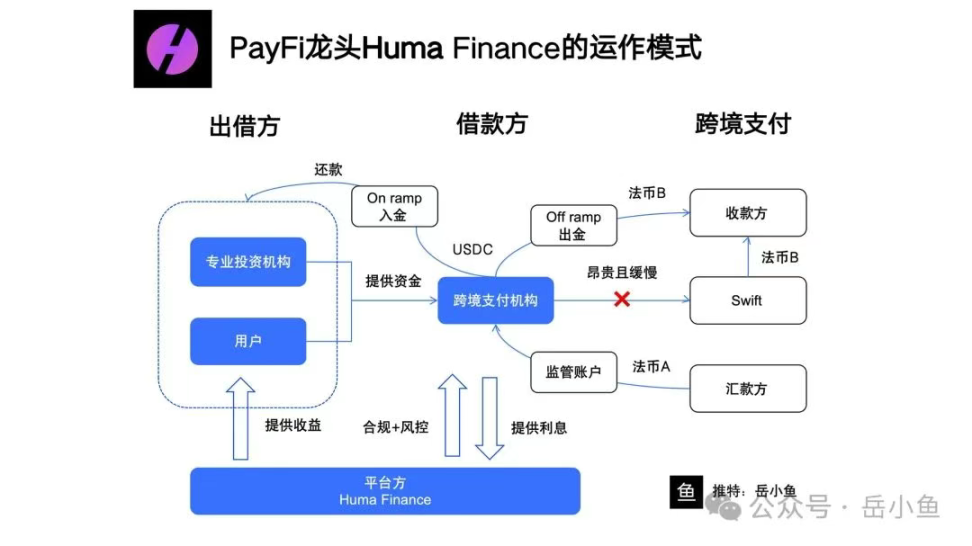Huma's core to gaining community trust lies in the ability to put this information on-chain in the future or directly disclose some information about borrowers, ensuring that the entire flow of funds is controllable.
Written by: Yue Xiaoyu
We can directly look at the overall business process of the Huma platform for a comprehensive understanding:
1. Users lend funds:
(1) Ordinary users (on-chain lenders) deposit stablecoins (USDC) through Huma's decentralized platform.
(2) No KYC is required; funds are locked through smart contracts to earn fixed returns.
(3) The funds enter Huma's lending pool for borrowers to use.
2. Cross-border payment institutions submit borrowing requests:
(1) Compliant cross-border payment institutions (such as licensed payment service providers) register on the Huma platform and submit loan applications;
(2) Purpose of the loan: to provide fast cross-border payment services for remitters (clients).
(3) Loan amount: typically for short-term funding (3-5 days), matching the scale of remittances.
3. Collateral custody:
(1) Payment institutions must provide equivalent fiat currency collateral, i.e., the fiat currency A (such as euros) paid by the remitter;
(2) The fiat currency is held in a regulatory account designated by Huma (managed by Arf, a licensed institution acquired by Huma).
4. Borrow USDC and execute payment:
(1) Huma issues a USDC loan to the payment institution through smart contracts;
(2) The payment institution uses USDC as an intermediary currency to transfer funds to country B via blockchain (Solana).
(3) In country B, the payment institution exchanges USDC for local currency B (such as USD) through local partners (exchanges or OTC service providers) and pays the recipient.
5. Repay the loan:
(1) The payment institution uses the held fiat currency A (collateral) or subsequent funds from the remitter to exchange for USDC within 3-5 days (the billing period) to repay the principal and interest of the loan to Huma.
(2) Huma returns the principal and earnings to the lenders, deducting platform fees (the interest margin, i.e., the difference between the borrowing rate and lending yield).
6. Earnings distribution:
(1) Lenders receive stable returns (assuming 10% annualized).
(2) Huma earns the interest margin (e.g., borrowing rate 15% - lending yield 10% = 5%).
(3) The payment institution earns customer fees through fast payment services (below 1%-3% of Swift) and covers borrowing interest costs.

Roles and positioning of each party in the entire business process:
We can see that Huma has built a lending platform where ordinary users act as lenders providing the source of funds, while cross-border payment institutions act as borrowers borrowing funds;
In the cross-border payment scenario, the remitter pays fiat currency A of country A. If using the traditional Swift settlement system, it takes 3-6 working days and incurs very high fees, involving exchange rate differences and currency conversion fees, usually 1%-3%.
Thus, after the cross-border payment institution receives the payment from the remitter, it does not go directly through Swift but instead uses USDC, a stablecoin, as an intermediary currency, borrows stablecoins on the Huma platform, and then directly cashes out USDC to local currency B in the target country B, completing the payment process on the same day.
Throughout the process, Huma provides short-term funding for cross-border payment institutions in the form of USDC for cross-border remittance settlement, while the cross-border payment institution needs to go through one cash-out and one cash-in.
Huma's borrowing side consists of compliant cross-border payment institutions that must provide equivalent fiat currency collateral (such as the remitter's local currency) and hold funds in a regulatory account to ensure risk control.
The lending side participates through on-chain smart contracts, requiring no KYC, and directly deposits stablecoins.
The platform must control the qualifications of the borrowing enterprises, loan applications, etc., and then earn the interest margin (the borrowing rate is higher than the lending yield).
It is important to mention Arf, the company acquired by Huma Finance:
Arf is a financial institution registered in Switzerland that can provide settlement services based on stablecoins for licensed payment institutions worldwide.
Therefore, after Huma acquired Arf, it directly resolved licensing and compliance issues, using this entity to conduct business.
It is important to note that the most troublesome and significant barrier to doing financial business is compliance.
Huma cleverly solved the compliance issue by acquiring a licensed institution, while also establishing its competitive barrier.
In summary:
The entire operation process and business model of Huma are relatively clear; however, the off-chain part is still a black box, leaving much room for operation.
Thus, the core of Huma gaining community trust is the future ability to put this information on-chain or directly disclose some information about borrowers, ensuring that the entire flow of funds is controllable.
It is also important to note that Huma aims to do more than just provide cross-border payment funding; this business is just a significant entry point, and it will expand into more businesses in the future:
Cross-border payments represent a $40 trillion market, while credit cards represent a $16 trillion market, and it can also expand into broader Trade Finance.
Overall, Huma is building a PayFi platform and PayFi ecosystem, which can be seen as a combination of practical and narrative projects, worthy of long-term attention.
免责声明:本文章仅代表作者个人观点,不代表本平台的立场和观点。本文章仅供信息分享,不构成对任何人的任何投资建议。用户与作者之间的任何争议,与本平台无关。如网页中刊载的文章或图片涉及侵权,请提供相关的权利证明和身份证明发送邮件到support@aicoin.com,本平台相关工作人员将会进行核查。




